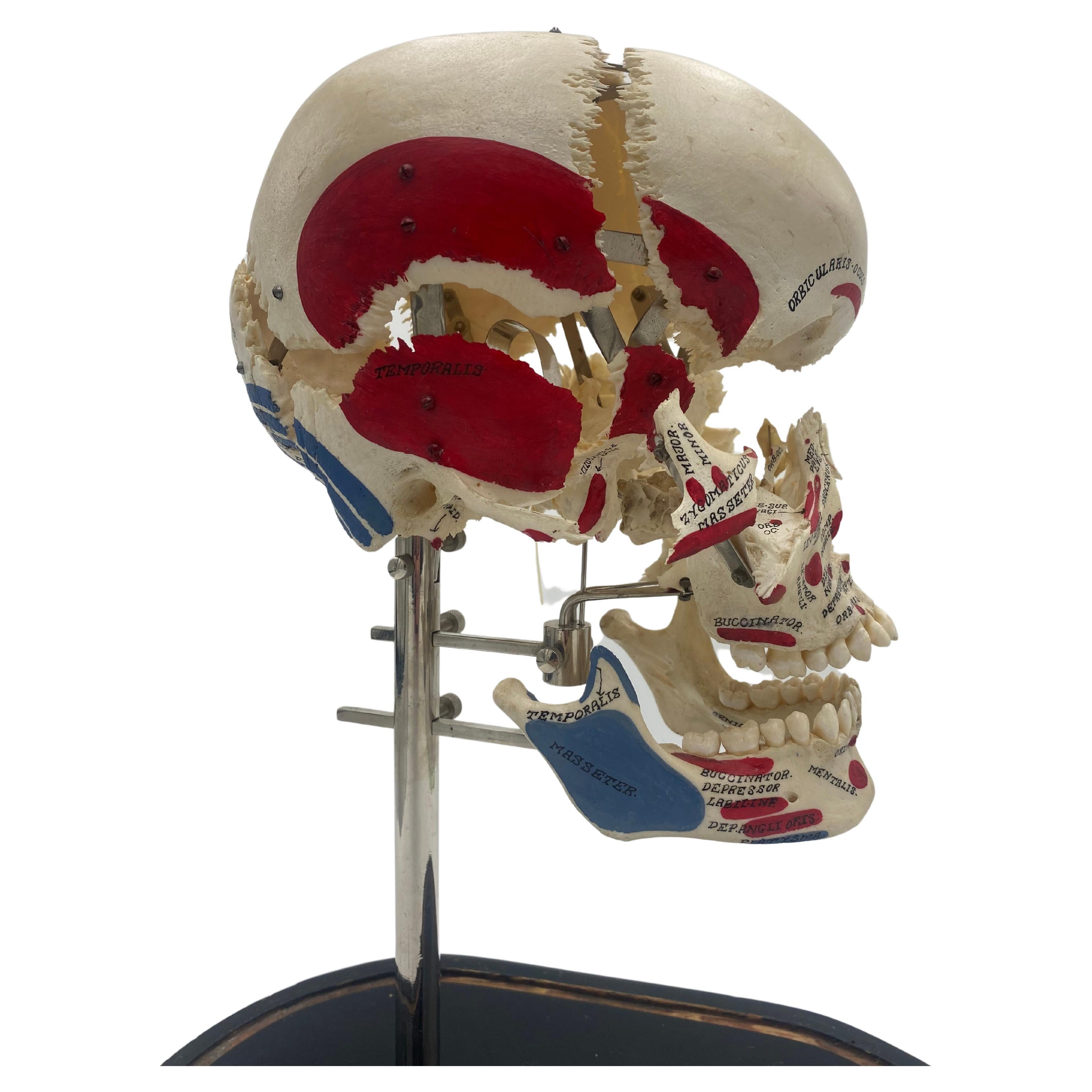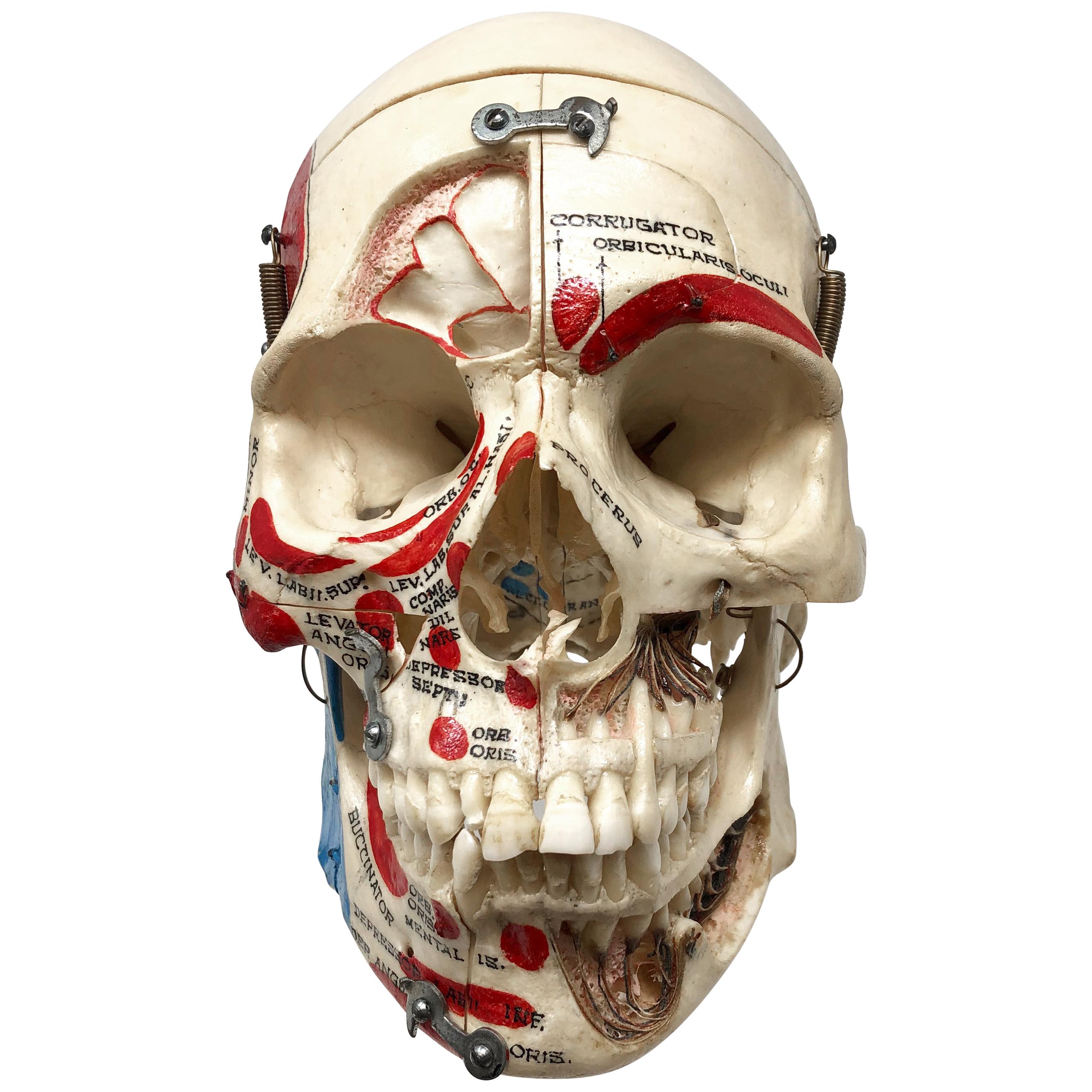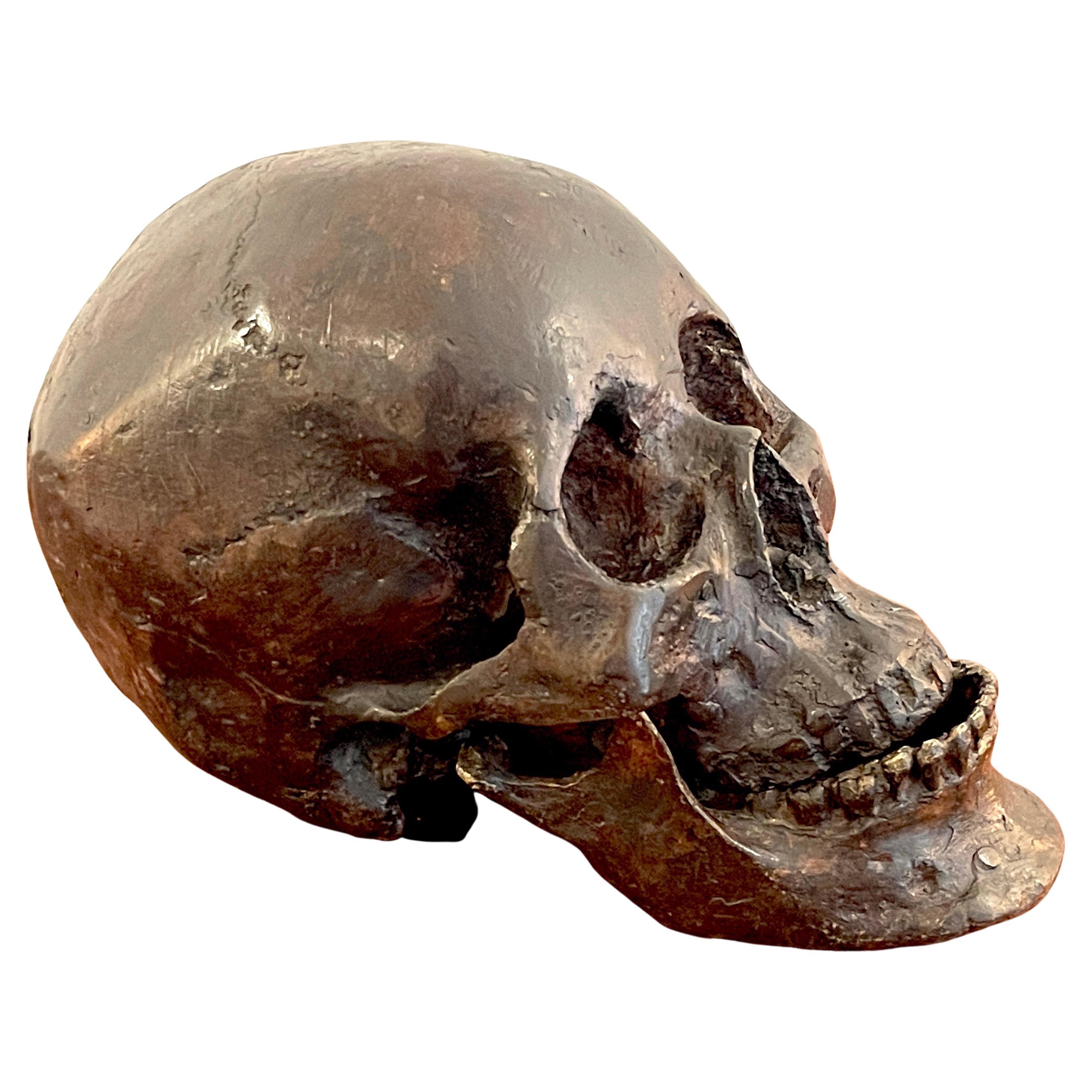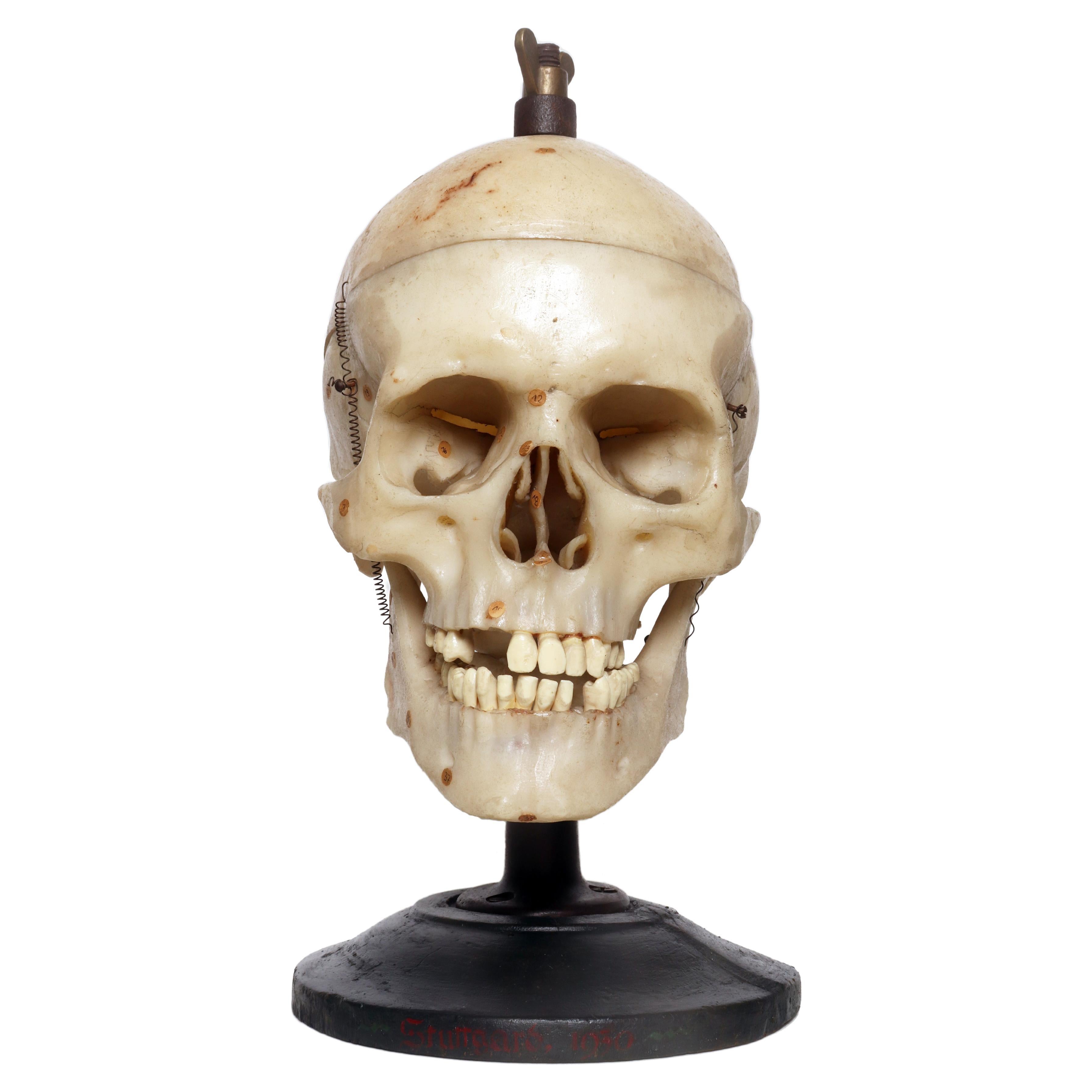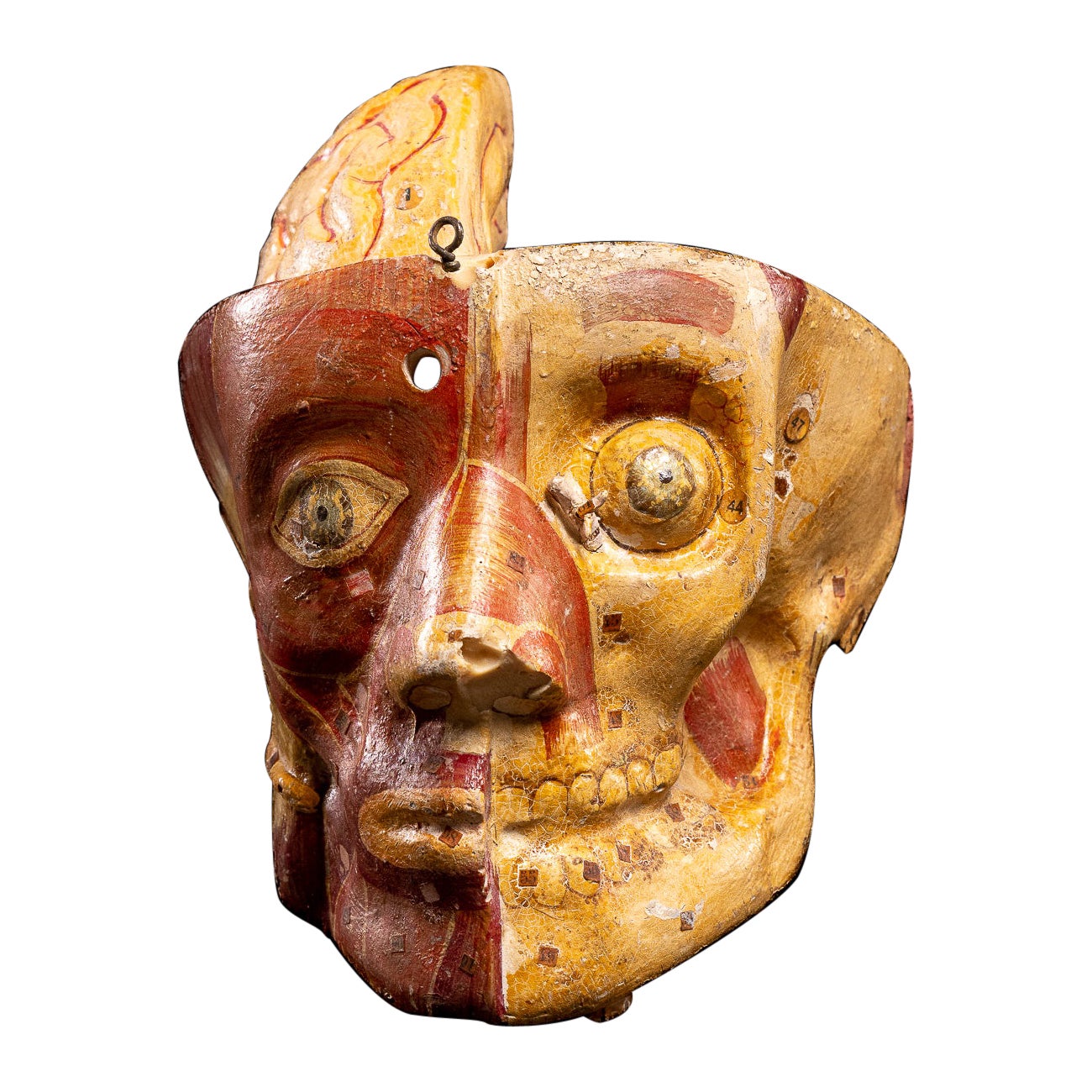Items Similar to Edmé Beauchêne disarticulated human skull with museum provenance, France
Want more images or videos?
Request additional images or videos from the seller
Edmé Beauchêne disarticulated human skull with museum provenance, France
About the Item
Edmé François Chauvot de Beauchêne (1780, Île-de-France – 1830, Paris), was a French physician, surgeon and anatomist. He was Chief of l'hopital Saint-Antoine Paris, the Deputy Chief of Anatomical Works of the Faculté de Médecine de Paris (both part of the University of France) and deputy head surgeon at Saint-Antoine. He was a member of the Société Anatomique de Paris and a Member of l'Academie de Médecine d'Île-de-France as well being the personal physician of Louis XVIII and the surgeon of Charles X He is buried in Père-Lachaise Cemetery.Edmé François Chauvot de Beauchêne was the inventor of the disarticulated or exploded human skull used for medical teaching, known as the Beauchêne skull. The skull bones are disarticulated along the sutures and mounted at a distance on brass supports. The bones are attached to the brass rods by rivets and the assembly is mounted on independent adjustable and modular brass rods which allow the jaw to advance and the top of the skull to be tilted back. Dentition is revealed with dissection of the left cortical bone showing the dental roots and with the nerve branches pigmented in red. One manufacturer was Maison Tramond, 9, rue de l'ecole de Medicine, Paris. The skulls were supplied by the medical school
Provenance
Collection Palmer Hudson, Curio Museum, Newquay (UK)
Belgian Private Collection
- Dimensions:Height: 27.56 in (70 cm)Diameter: 12.6 in (32 cm)
- Materials and Techniques:
- Place of Origin:
- Period:
- Date of Manufacture:-
- Condition:Wear consistent with age and use. Minor losses.
- Seller Location:Leuven , BE
- Reference Number:
About the Seller
5.0
Platinum Seller
These expertly vetted sellers are 1stDibs' most experienced sellers and are rated highest by our customers.
Established in 2017
1stDibs seller since 2017
164 sales on 1stDibs
Typical response time: 4 hours
- ShippingRetrieving quote...Ships From: Leuven , Belgium
- Return PolicyA return for this item may be initiated within 3 days of delivery.
More From This SellerView All
- Lifesize 19 Th C Bronze Momento Mori Cast of a Human Skull.French CollectionLocated in Leuven , BEA lifesize Bronze Momento Mori cast of a Human Skull.19th C.Category
Antique 19th Century French Figurative Sculptures
MaterialsBronze
- Anatomical Cut of Human Skull Papier-maché, Didactical Collectables, Dr.AuzouxBy Dr. Louis AuzouxLocated in Leuven , BEAnatomical cut of a human skull composed in natural painted papier-maché, with numbered labels on the different elementsCategory
Antique 19th Century French Scientific Instruments
MaterialsPlaster, Paper
- Anatomical Model of Human Eye Papier-maché, Scientific Collectables, Dr.AuzouxBy Dr. Louis AuzouxLocated in Leuven , BEAnatomical cut of one eye, composition in natural painted papier-maché, with numbered labels on the different elements / the opening eyeball to cover the removable pute. Pen annotati...Category
Antique 19th Century French Scientific Instruments
MaterialsPlaster, Paper
- Eurasian Eagle Owl 'Bubo bubo' on Antique White Museum Stand, 1910Located in Leuven , BESpecies preconvention 01/06/1947 can be commercialised in accordance with rule n°338/97 CE dated 09/12/1996. The Eurasian eagle-owl (Bubo bubo) is a species of eagle-owl that resi...Category
20th Century French Taxidermy
MaterialsOrganic Material, Wood
- Eskimo Model Kayak, Wood Covered with Seal Skin, Lined with BoneLocated in Leuven , BEWhat makes this model so special is that all the hunting devices are still present: spears, harpoons, spear thrower, wood float board, and bladder, paddles and other equipment used for seal hunting. Please note how well these are made in a stunning combination of wood and bone and lashed on deck under bone and sinew spear securers. Despite the kayak frame...Category
Vintage 1930s American Models and Miniatures
MaterialsAnimal Skin, Wood
- Haussa People, Nigeria, Dagger with Organic HandleLocated in Leuven , BEBeautifully crafted dager from Nigeria (Haussa People) with an organic handle. Hausa people are frond in northwestern Nigeria and adjacent southern Ni...Category
20th Century Nigerian Tribal Art
MaterialsMetal
You May Also Like
- Seldom Seen Authentic Exploding Skull, Medical, After Claude BeauchêneBy Claude BeaucheneLocated in Buffalo, NYAuthentic Exploding Skull Originally created by Edmé François Chauvot de Beauchêne (ca.1780-1830), a French anatomist and surgeon, developed this disarticulation method to comprehensively show all the cranial bones and their connections. The exploded skull...Category
Early 20th Century French Industrial Scientific Instruments
MaterialsMetal
- Kilgore Authentic Anatomical Preparation Human SkullLocated in Hamilton, OntarioPrepared by legendary medical supply company Kilgore International, this is an advanced anatomical reference human skull! An exceptional authentic vint...Category
Vintage 1950s American Models and Miniatures
MaterialsBone
- Life Cast Bronze Model/Sculpture of a Human SkullLocated in West Palm Beach, FLLife Cast Bronze Model/Sculpture of a Human Skull Signed and copyrighted Indistinctly, possibly by Maxilla and Mandible Ltd. New York Realistically cast and modled, in two parts with upper and lower jaws. This skull vanity (or vanitas) is a representative scientific model or a 'memento mori' , which was informed popular thinking during the late Middle Ages and early Renaissance about human mortality. This sculpture/ model was made from a real human skull...Category
20th Century Figurative Sculptures
MaterialsBronze
- Anatomical model: a human skull model life size, Stuttgard, Germany 1930.Located in Milan, ITHuman skull anatomical model life size 1:1 Model with cranial sutures detachable 2 parts plus three cervical vertebrae for medical educational aid. The skull and vertebrae are made o...Category
Mid-20th Century German Scientific Instruments
MaterialsIron
- 19th Century French Nickel Silver Hunting Dog Collar with Engraved ProvenanceLocated in Chillerton, Isle of Wight19th century French nickel silver hunting dog collar with engraved provenance This 19th century French nickel silver hunting dog collar, is engraved giving the piece the necessary...Category
Antique Early 19th Century Brutalist Historical Memorabilia
MaterialsNickel
- American Hepplewhite Virginian Secretary Chest with Civil War ProvenanceBy George HepplewhiteLocated in Dallas, TXPRESENTING a FANTASTIC and HISTORIC Early 19C American Hepplewhite Virginian Secretary Chest with OUTSTANDING Provenance. This Secretary Chest was made in Virginia in the Early 19th Century, circa 1810. It is made of cherry, walnut and maple and is most definitely in the Hepplewhite Style of the period, with it’s original Hepplewhite brass drawer pulls. IT IS A REALLY INTRIGUING AND HISTORIC PIECE, ESPECIALLY, WHEN VIEWED IN CONTEXT WITH IT”S AMAZING PROVENANCE! This piece was originally owned by Major William Alexander Obenchain who ‘hailed’ from the State of Virginia. He was an engineer and was in the Virginia Corps of Engineers during the Civil War and served on General Robert E. Lee’s staff. It was acquired by him before the Civil War and we believe that this piece was on campaign with him during the War. We know for a fact that he fought at the Richmond Campaign in 1864, as we have, in our Collection, his original Field Map for that Campaign which ended the War. It has remained in family ownership ever since. It has come directly from the Family Estate, together with other VERY IMPORTANT items belonging to Major Obenchain and other IMPORTANT items that belonged to his wife, Eliza Calvert Hall-Obenchain. ALL these items contained in the Collection, are listed/posted individually on our Website. The top drawer is on retractable curved side hinge supports and pulls outwards and drops to reveal a secretary and writing area. The Bureau/Secretary Gallery has 6 drawers and 6 cubbies, a central tabernacle door with another drawer and 2 cubbies and this is flanked by 2 secret pull out compartments. The central tabernacle door has it’s original key and working lock. Closed, it is almost ‘flush’ like the rest of the drawers, with some very minor bowing through age. The 3 drawers underneath are graduated in size and it ends with a serpentine shaped base and sits on four hand carved legs with original metal casters, marked ‘Universal 3’. It has it’s original brasses and hardware throughout, save the addition to 2 contemporary replacement brass hinges to the drop down desk front, as the original hinges were broken, could not be repaired and were not supporting the weight of the drop down leaf. Some minor repairs but not noticeable. Otherwise, the piece is in it’s entirely, ORIGINAL condition! What makes this piece even MORE INTRIGUING and APPEALING HISTORICALLY, are the 2 ‘historic’ circular holes on the piece:- (1) in the back of the piece as seen in the photos. This hole is not symmetrical or fully round and appears to serve no purpose to the piece whatsoever. Sometimes, pieces have holes for wiring for lighting, put in them over the years, but this one never had such lighting or, indeed, any such explanation for this hole, AND (2) the rear hole is replicated, in the corner portion of the bottom drawer and someone (a very long time ago) has used a tin can top, to cover the hole in the back of the drawer. The tin can top is period to the Civil War Era and is embossed “Minimum Volume 1 Pint”. Our conclusion, is that (whilst we are, by no means ballistic experts) that these holes were created by musket balls, fired during one of the Major’s campaigns in the Civil War. It is entirely conceivable that this piece, being strapped into a covered wagon for carriage, would have been on it’s side. We are of the opinion that both holes, were caused or created by a musket ball entered the chest trough the base and back. We also believe that ‘the Major’, used what he had at his disposal on the battlefield, namely, a tin can lid to repair the hole in the drawer. SO THIS PIECE IS A VERY SPECIAL PIECE OF US HISTORY, INDEED! NOT ONLY IS IT AN EARLY 19th CENTURY AMERICAN PIECE, WITH A CONNECTION TO THE STATE OF VIRGINIA, THE CIVIL WAR, HISTORIC & IMPORTANT FIGURES IN THAT WAR AND IMPECCABLE PROVENANCE AND HISTORY! IT IS TRULY UNIQUE! William Alexander Obenchain. Born April 27, 1841 at Buchanan, Botetourt Co., Virginia. Parents: Thomas Jefferson Obenchain and Elizabeth Ann Sweetland. Entered VMI on July 18, 1859 as a member of the VMI (Virginia Military Institute...Category
Antique Early 19th Century American American Classical Historical Memora...
MaterialsBrass
